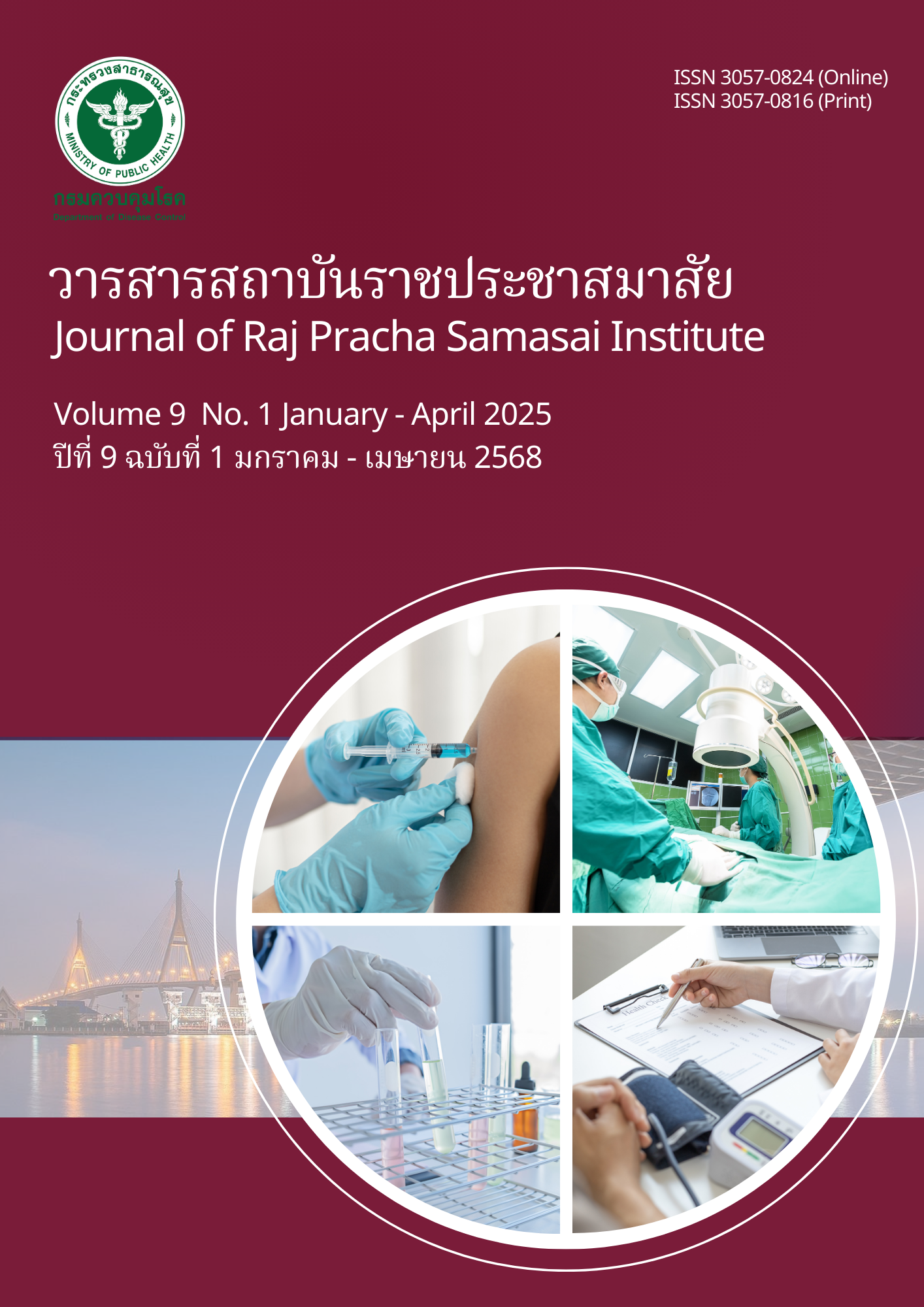Stroke Patients’ Experiences after inpatient stroke intermediate care Rehabilitation at Chiang Mai Neurological Hospital: Qualitative Research
Main Article Content
Abstract
This qualitative study aims to explore the experiences of stroke patients after inpatient stroke intermediate care rehabilitation at Chiang Mai Neurological Hospital. The participants were 10 stroke patients who received inpatient intermediate care rehabilitation at the hospital between August and October 2023. Phenomenological research was applied in this study. Data were collected through in-depth interviews based on research questions developed
by the researchers and approved by experts. The data were analyzed using content analysis.
The results revealed three key themes: (1) Experience in inpatient stroke intermediate care rehabilitation: Reasons for receiving services for continued treatment under their healthcare scheme, received recommendations from previous patients, and the availability of qualified personnel, facilities, and advanced technologies. Key-informants received physical therapy, occupational therapy and some patients received robotic assisted gait training as part of their rehabilitation. (2) Problems and barriers: Lack of caregivers, which limited their opportunities for receiving care, disrupted service continuity due to weekends and holidays, and a lack of understanding about stroke. (3) Service needs: Key-informants expressed a desire for more intensive rehabilitation, rehabilitation services on weekends, supportive equipment for rehabilitation, and more information about stroke. The findings of this study can inform the development of more effective and efficient intermediate care rehabilitation services for stroke patients, helping to enhance both the quality and outcomes of care.
Downloads
Article Details

This work is licensed under a Creative Commons Attribution-NonCommercial-NoDerivatives 4.0 International License.
ประกาศเกี่ยวกับลิขสิทธิ์
บทความที่ลงพิมพ์ในวารสารสถาบันราชประชาสมาสัย ถือว่าเป็นผลงานทางวิชาการหรือการวิจัย และวิเคราะห์ตลอดจนเป็นความเห็นส่วนตัวของผู้นิพนธ์ ไม่ใช่ความเห็นของกรมควบคุมโรค ประเทศไทย หรือกองบรรณาธิการแต่ประการใด ผู้นิพนธ์จำต้องรับผิดชอบต่อบทความของตน
นโยบายส่วนบุคคล
ชื่อและที่อยู่อีเมลที่ระบุในวารสารสถาบันราชประชาสมาสัย จะถูกใช้เพื่อวัตถุประสงค์ตามที่ระบุไว้ ในวารสารเท่านั้น และจะไม่ถูกนำไปใช้สำหรับวัตถุประสงค์อื่น หรือต่อบุคคลอื่นใด
References
Health Data Center. Stroke incidence rate and stroke mortality rate [Internet]. Nonthaburi. The Permanent Secretary Ministry of Public Health; 2024 [cited 2024 Sep 4]. Availablefrom: https://hdcservice.moph.go.th/hdc/reports/%20report.php?source=pformated/format1.php&cat_id=6a1fdf282fd28180eed7d1cfe0155e11&id=b717285d1ebab38e6cf30ca2846317cd. (in Thai)
Kitisomprayoonkul W, Nuengnit Y, Panyasriwanit S. Rehabilitation medicine textbook. 4th ed. Bangkok: Chulalongkorn University Press; 2017. (in Thai)
Ministry of Public Health (TH), Health Administration Division. Subcommittee on Health Service System Development in the field of Intermediate Care. Guideline for intermediate care. Bangkok: Health Administration Division; 2019.
Homklin P. The effectiveness of physical therapy rehabilitation in subacute stroke patients in the physical therapy department medicine Surin Hospital. Mahidol R2R e-Journal. 2021;8(3):74-82. (in Thai)
Mankong S, Nopparat P, Panyako N. Effects of intermediate phase rehabilitation program for stroke patients at Thapla Hospital. emh. 2021;7(1):96-107. (in Thai)
Namchandee A. Outcomes of intermediate rehabilitative care in sub-acute stroke patients. Buddhachinaraj Med J. 2021;38(3):356-67. (in Thai)
Pattanasuwanna P. Outcomes of intermediate phase post-stroke inpatient rehabilitation in community hospital. ASEAN J Rehabil Med. 2019;29(1):8-13. (in Thai)
Tongsephee R. The outcomes of intermediate phase rehabilitation in Thasala Hospital. MNST Med J. 2020;4(1):1-10. (in Thai)
Utrarachkij N, Reecheeva N, Siriratna P, Thamronglaohaphan P, Chira-adisai W. Functional outcomes of upper and lower limbs after rehabilitation program in sub-acute and chronic stroke patients at Ramathibodi Hospital. J Thai Rehabil Med. 2016;26(2):47-53. doi: 10.14456/jtrm.2016.10 (in Thai)
Chantani M. Qualitative Research Model. JAIS. 2022;4(1):233-45. (in Thai)
Longlalerng C, Tospatinrat S, Pinkaew C, Boontha N. Hemiplegic Patient’s Experiences after the Virtual Reality Technology (Toucher) Rehabilitation: A Qualitative Study. J DMS. 2023;48(1):27-34. (in Thai)
Paksee N, Sirapo-ngam Y, Monkong S, Leelacharas S. Effects of a transitional care program for stroke patients and family caregivers on caregiver’s preparedness, stress, adaptation, and satisfaction. Nurs Res Inno J. 2016;22(1):65-80. (in Thai)
Clark B, Whitall J, Kwakkel G, Mehrholz J, Ewings S, Burridge J. The effect of time spent in rehabilitation on activity limitation and impairment after stroke. Cochrane Database Syst Rev. 2021;10(10):CD012612. doi: 10.1002/14651858.CD012612.pub2
Wiriyakijpaiboon J, Jitpanya C. Relationships among knowledge, perceived benefit, depression, social support and secondary stroke prevention in stroke survivors. JPNHS. 2016;8(2):34-44. (in Thai)
Jaisan T, JamChat R. Development of gait training program at home in stroke patients with assistive devices. Med J Sisaket Surin Buriram Hosp. 2019;34(3):349-57. (in Thai)


